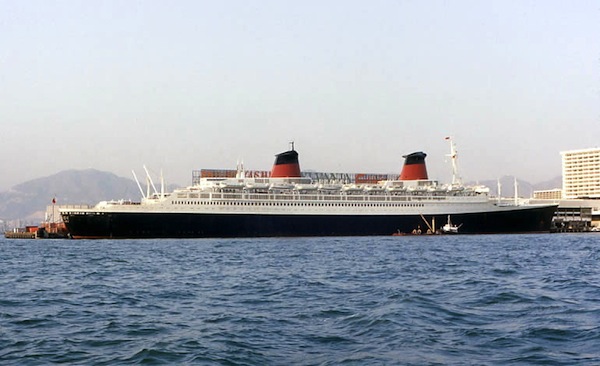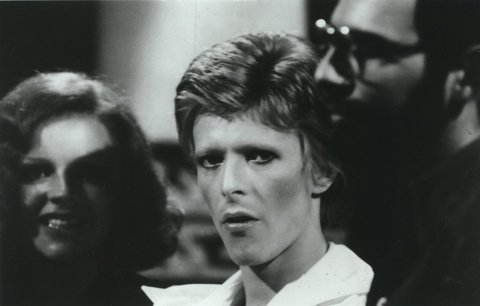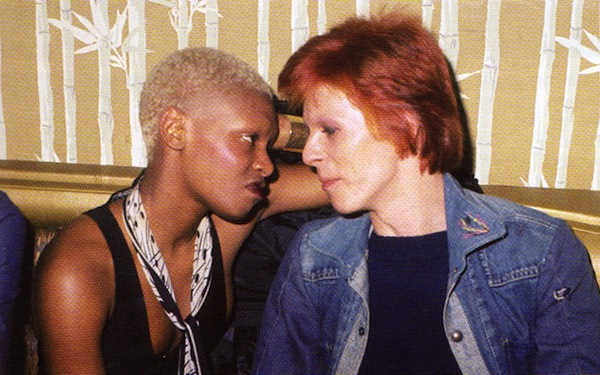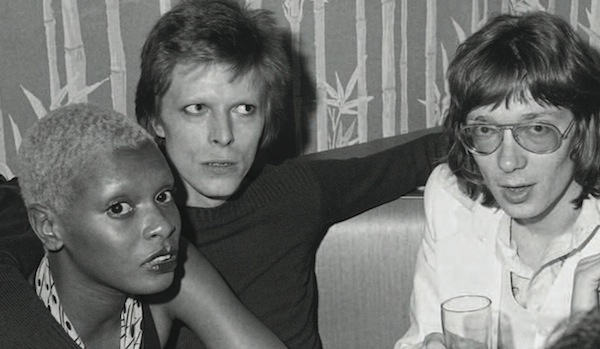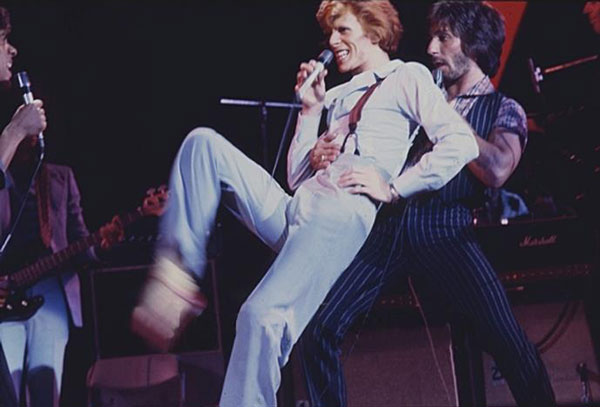1970 • 1971 • 1972 • 1973 • 1974
1975 • 1976 • 1977 • 1978 • 1979 • 1980
THE MAN WHO SOLD THE WORLD • HUNKY DORY
THE RISE AND FALL OF ZIGGY STARDUST
AND THE SPIDERS FROM MARS
ALADDIN SANE • PINUPS • DIAMOND DOGS
YOUNG AMERICANS • STATION TO STATION
LOW • HEROES • LODGER • SCARY MONSTERS
ZIGGY STARDUST THE MOTION PICTURE
THE 1980 FLOOR SHOW • CRACKED ACTOR
THE MAN WHO FELL TO EARTH • THE ELEPHANT MAN
FEATURES • PRESS ARCHIVE
BOWIEGOLDENYEARS is currently being expanded and redesigned
gold page links are live
JANUARY 1974
Bowie arrives at Olympic Studios • photograph © Denis O'Regan Tuesday January 1 Recording session Studio 2, Olympic Studios, Barnes Take It In Right Take It In Right (later retitled Can You Hear Me) was written for Lulu as a follow up single to The Man Who Sold The World; Candidate was intended for the projected Nineteen Eighty-Four musical. Candidate released: Tuesday January 8 Metropolis with Amanda Lear and George Underwood
Friday January 11 The Man Who Sold The World 3:58 • Watch That Man 5:11 Lulu single released in UK Both tracks reissued on Bowie supplied the backing track and supervised the sound for Lulu's appearance on Top Of The Pops performing the song in a black suit.
Monday January 14 Diamond Dogs recording session Rock 'N' Roll With Me
Bowie was also working Are You Coming? Are You Coming? for the Nineteen Eighty-Four stage show, now renamed The 1980 Floor Show, to avoid any copyright problems which might otherwise arise. Olympic threatened to ban Bowie from the studio until they were paid outstanding studio fees, so he shelved the Astronettes project. Instead they would make Ava's solo album later in the year. • Astronettes recordings released as People From Bad Homes (Golden Years 1995)
Wednesday January 30 Diamond Dogs photo session with Terry O'Neill
Bowie met with Belgian artist Guy Peellaert at his hotel to discuss artwork for the Diamond Dogs album cover, then joined Terry O'Neill at a hired studio for the photography, on which Peellaert would base the cover art.
FEBRUARY 1974 Diamond Dogs production With Olympic Studios no longer an option, Bowie turned to Tony Visconti.
Thursday February 7
Amstel Hotel, Amsterdam • Photograph © Peter Mazel Wednesday February 13 Press conference Ad Visser, host of Dutch music show Top Pop, presented Bowie with the Edison award for the Most Popular Male Vocalist, then poured two glasses of Schelvispekel, 'an old fishermen's drink'. Bowie quipped, “It tastes like old fishermen.” Bowie's Freddie Burretti-designed outfit was inspired by Carmen, the flamenco rock group who had appeared on The 1980 Floor Show in October.
* Dutch journalist Elly de Waard took the jacket as retribution for being refused an interview with Bowie. She has since paraded it at staged events. Top Pop television appearance Director: Rien van Wijk Rebel Rebel Edison Awards ceremony, Amsterdam The Edisons – the Dutch equivalent of the Grammys – included a performance by Tony Orlando and Dawn singing their hit Tie A Yellow Ribbon. Orlando broke off singing the last verse when he spotted Bowie and Angie in the audience: “I can't believe what I see… Is that you?”
• Broadcast: Grand Gala du Disque (AVRO) Thursday February 14 Diamond Dogs album production Friday February 15
Rebel Rebel 4:22 • Queen Bitch 3:14 single released in UK Friday February 22 Mick Ronson plays the Rainbow Theatre, London His band included Trevor Bolder, Mike Garson, Ritchie Dharma and Mark Pritchett. Thursday February 28
• Read: Beat Godfather Meets Glitter MainMan, Rolling Stone magazine
March 1974 Friday March 1
Slaughter on 10th Avenue Mick Ronson album released in UK Tracks include MainMan promoted Ronson's first album with all the fanfare of an established star. A coinciding UK tour helped Slaughter on 10th Avenue to its chart debut at number 9. Saturday March 2 Rebel Rebel peaks at number 5 in the UK charts Thursday March 7 Bowie takes delivery of Guy Peellaert's Diamond Dogs artwork. The album would be in the record shops six months before The Rolling Stones album It's Only Rock 'N' Roll. also with a Peellaert cover.
The Diamond Dogs cover painting © Guy Peellaert
Friday March 8
The Bowies with Guy Peellaert at his Rock Dreams exhibition/book launch in the Rainbow Room at Biba, London © Archiv Hauke
The Rock Dreams cover painting included Bowie in the pantheon
Bowie in a Rock Dreams double spread with Lou Reed Mid March Plans for the West End stage show of Nineteen Eighty-Four were ditched in favour of an extensive American tour with a strong theatrical element. Broadway designer Jules Fisher flew to London and met with Bowie who briefed him on the concept for the Diamond Dogs stage show. Fisher then brought in Mark Ravitz to design the Hunger City set.
On Angie's recommendation, Bowie brought in Toni Basil, a choreographer working with The Lockers, an urban dance troupe with a street sense that fitted Bowie's Diamond Dogs concept.
Corinne Schwab (or Coco, as Geoff MacCormack nicknamed her) was planning to move on from the London MainMan office, where she'd been keeping creditors at bay, and was now assisting Bowie.
Gloria Harris had moved on so Bowie appointed Coco as his personal assistant, a position she held until Bowie passed away. Friday March 22
Weren't Born A Man Dana Gillespie album released in UK Tracks include Monday March 25 Lulu recording session David Bowie (guitar, production) Can You Hear Me Friday March 29 London to Paris While Mick Ronson worked on string arrangements for Can You Hear Me in London, Bowie and MacCormack travelled to Paris, where they stayed at the Raphael Hotel and ran into Ron Wood. April 1974 Monday April 3 Paris to New York via Cannes After stopping off for a couple of hours at the Carlton Hotel in Cannes, Bowie and MacCormack boarded SS France for New York.
After Bowie heard the crew were disappointed that he was not scheduled to play on the voyage, he turned up in the canteen with an acoustic guitar.
Thursday April 11 New York On arrival, Bowie autographed fan club booklets then checked into the Sherry Netherlands Hotel on Fifth Avenue.
Bowie signs autographs on the New York docks Friday April 12
Rock 'N' Roll Suicide 2:58 • Quicksand 5:03 single released in UK The first record credited just ‘Bowie' and his first RCA single to miss the British Top 20 since Changes in January 1972. Mid April Diamond Dogs recording and television Rebel Rebel [US new version]
With Cherry Vanilla • Photographs © Macs McAree Cherry Vanilla produced the television commercial for the upcoming Diamond Dogs album as Bowie was reworking Rebel Rebel for the American market, with tape effects, more percussion and a new arrangement, which he retained for the 1974 tour.
Work also resumed on Lulu's Can You Hear Me sessions. The guitarist was Carlos Alomar.
Bowie asked Alomar to work on the tour starting in June. DeFries refused to match Alomar's pay at the time ($800 a week) so Alomar declined. Wednesday April 17 Rodin - Mis en Vie, New York Bowie, MacCormack and Cherry Vanilla attended the New York premiere of the ballet based on the life of sculptor Auguste Rodin. Bowie was impressed with the performance and staging concepts. He met Michael Kamen, who scored the production, and invited him to join the tour as musical director. Friday April 19 Todd Rundgren's Utopia at Carnegie Hall, New York Bowie and Ava Cherry attended the concert and the Bearsville Records aftershow party at Shun Lee restaurant.
Bowie makes his entrance • Photograph © Bob Gruen
With Ava Cherry • Photograph © Bob Gruen Sounds writer Martin Kirkup interviewed Bowie about his first week in New York, the tour plans and the imminent release of the new album Diamond Dogs. Bowie also caught up with Melody Maker US Editor Chris Charlesworth who reported that “he drank champagne with his companion Ava Cherry and fled when the snapping flashbulbs began to irritate.”
With Ava Cherry and Chris Charlesworth • Photograph © Bob Gruen
May 1974
Rebel Rebel 2:58 • Lady Grinning Soul 3:19 single released in US Saturday May 4 'Diamond David' by Martin Kirkup published in Rock magazine Friday May 24
Diamond Dogs album released Side one Side two
JUNE 1974 Sunday June 2 Roxy Music at Academy of Music, New York Bowie and Ava Cherry attended the aftershow party at the East Village loft of artist Larry Rivers.
Bryan Ferry, Amanda Lear, Bowie and Shaun Cassidy
Shaun Cassidy, Bowie and unknown guest • Photograph © Dagmar Saturday June 8 – Monday June 10 Tour rehearsals at Capitol Theater, Port Chester Diamond Dogs Tour David Bowie (vocals) The Diamond Dogs tour was originally planned to play five or so nights in each city, before moving on to the next city. The set cost $200,000 and the props $75,000.
Production run sheet detailing choreography and set changes Friday June 14
Diamond Dogs 6:03 • Holy Holy 2:16 single released in UK Forum, Montreal The preparation of the Hunger City stage was complete, but the sound system was overloaded and distorted and the bridge crashed to the ground with Bowie on it. The sound company was replaced and Porsche brakes were installed in the bridge. Hearing of this, Bowie quipped, “A Porsche brake? Isn't that how James Dean died?”
Saturday June 15 Civic Center, Ottawa
Sunday June 16 O'Keefe Auditorium, Toronto (2 shows) The technical problems were resolved but Bowie suffered from laryngitis. Despite this he put on a “perfect show” impressing the group of US and UK writers DeFries had flown in. • Report by Leee Black Childers in Hit Parader magazine Monday June 17 War Memorial Auditorium, Rochester Tuesday June 18 Public Auditorium, Cleveland Thursday June 20 Sports Arena, Toledo Saturday June 22 Cobo Arena, Detroit The show was transferred from Ford Hall at the last minute when they found the stage was too small to fit the set.
Angie and Zowie backstage in Detroit • Report by Leee Black Childers, Hit Parader magazine • Report by Lenny Kaye, Disc and Music Echo Sunday June 23 Cobo Arena, Detroit (cancelled) Monday June 24 Hara Arena, Dayton Tuesday June 25 Cincinnati Gardens (cancelled) Wednesday June 26 Syria Mosque, Pittsburgh Thursday June 28 Civic Center, Charleston Friday June 29 Municipal Auditorium, Nashville
Backstage, Municipal Auditorium • Photograph © Linda McCartney Saturday June 30 Mid-South Coliseum, Memphis JULY 1974 Monday July 1 Fox Theatre, Atlanta Tuesday July 2 Curtis Hixon Hall, Tampa During the journey to Tampa, the driver of the truck containing most of the set is stung by a bee and crashes.
Bowie received a 20-minute ovation and returned for an encore. Wednesday July 3 Jai-Alai Fronton, Orlando Thursday July 5 Park Center Coliseum, Charlotte Friday July 6 Coliseum, Greensboro Saturday July 7 Scope Convention Center, Norfolk Sunday July 8 – Saturday July 13 Tower Theater, Philadelphia Bowie's band discovered that the Philadelphia shows were to be recorded (for David Live), and that they would be paid the standard show fee. Herbie Flowers (pictured below, wearing pyjamas) protested to Bowie and DeFries, saying they would not go on without an increased fee in line with the normal recording rates. On the basis of the likely sales of the album they calculated they were entitled to $50,000 ($5000 each). Bowie relented, MainMan handed over the cheques (which some claim were never honoured) and the band went on and played the show.
Tony Visconti was unable to get to the venue in time so David Live was recorded without him. Engineer Keith Harwood was left to do the job alone. The incorrect microphone placement meant that the instruments were not isolated properly, making the recording more difficult for Visconti to mix later. Monday July 9 Production began on Ava Cherry's promised solo album with a day in Philadelphia's Sigma Sound Studios with Michael Kamen, recording three songs – Everything That Touches You, Give It Away and Sweet Thing.
Friday July 12
Sunday July 14 Veterans Memorial Coliseum, New Haven Monday July 15 Palace Theater, Waterbury Tuesday July 16 Music Hall, Boston Wednesday July 17 Bushnell Auditorium, Hartford David Live post production
Some of the backing vocals had to be rerecorded due to loss of microphone contact during the shows. The whole process was rushed in order to maximise sales and publicise the rest of the tour. In the midst of all this, Tony DeFries and his wife Liz divorced. According to his niece, "he was very nice until all this Bowie thing began." Friday July 19 Madison Square Garden, New York
Madison Square Garden • photograph © Dagmar Promoter Ron Delsener threw a party at the Plaza Hotel for 40 guests including Mick Jagger. Bette Midler arrived with two of her Harlettes, Charlotte Crossley and Sharon Redd. The New York concerts were videotaped for MainMan by John Dove for Bowie to review later. Bowie had become interested in video, so Dove taught him how to shoot, edit and apply effects. August 1974
1984 • Queen Bitch single released in US Bass guitarist Herbie Flowers and drummer Tony Newman left the touring band, and were replaced by Willie Weeks and Andy Newmark. Sunday August 11 – Thursday August 22
Young Americans recording sessions Bowie had been impressed by the studio when Ava Cherry was recording there in July. He also liked their connection with the Gamble and Huff recordings. Bowie and entourage stayed at the The Barclay on Rittenhouse Square for the duration of the sessions at Sigma. Cracked Actor British filmmaker Alan Yentob arrived to make a documentary on Bowie's experiences in America for BBC's Omnibus program.
The idea had occurred to Yentob the year before, when Bowie described himself on Russell Harty's show as “a collector – I collect things”. Both Terry O'Neill and Alan Yentob were on hand to document the sessions, including Right with Luther Vandross and Carlos Alomar's wife Robin Clark.
Bowie, Clark and Cherry rehearsing Right
Bowie and Mike Garson • Photograph © Terry O'Neill A group of devoted Philadelphia fans, dubbed the Sigma Kids, staked out Sigma Studios and the Barclay Hotel, where Bowie would emerge each evening. They took pictures of him walking to the limo, and then quickly drove across town to Sigma Sound in time to see him arrive. Thursday August 22 After a long night of finishing touches to vocals and keyboard overdubs, Bowie invited the Sigma Kids into the studio. Photographer Dagmar followed them in to document the occasion.
All photographs © Dagmar In eight days, they had recorded nine basic backing tracks for most of the album but only some of these made it on to the finished album.
The rest came together in November, December and the following January. Who Can I Be Now?, It's Gonna Be Me and After Today were later dropped from the album but issued on later releases: Saturday August 24 Philadelphia to Los Angeles Bowie began the three-day rail journey to Los Angeles for the West Coast tour, starting with seven already sold-out Universal Amphitheatre dates. Friday August 30 Young Americans cover photo session, Hollywood With the album considered to be finished, Bowie worked on ideas for the sleeve design. He settled on a design based on the cover of the latest issue of After Dark, a hand tinted portrait of his tour choreographer Toni Basil by photographer Eric Stephen Jacobs that evoked old Hollywood glamour.
He called Jacobs in New York and flew him to Los Angeles for the shoot which took place on a Hollywood soundstage. Back in his New York studio, Jacobs replicated the style of his previous portrait, including the hand colouring and the handpainted cigarette smoke, curling upwards to the title.
SEPTEMBER 1974 Young Americans promotional photo session with Terry O'Neill
Polaroid test shot
Diamond Dogs West Coast Tour David Bowie (vocals)
Rehearsals, Los Angeles • Photograph © Terry O'Neill Monday September 2 Universal Amphitheatre, Los Angeles
Los Angeles • Photograph © Terry O'Neill Robert Hilburn reviewed the first night and afterwards came to the Beverly Wilshire to talk about the new live album, but instead Bowie played him tracks from the Young Americans album, at that time tentatively titled One Damn Song.. "This isn't the new album,” Bowie told him, “but the one after it, and the record company doesn't like me to do that. We cut it in a week in Philadelphia and it can tell you more about where I am now than anything I could say." Tuesday September 3 Universal Amphitheatre, Los Angeles Alan Yentob's crew filmed the Thursday night concert for the BBC Omnibus documentary Cracked Actor. The live footage included excerpts of Rebel Rebel, Moonage Daydream, Cracked Actor, Sweet Thing, Aladdin Sane, Time, Rock 'N' Roll Suicide, Diamond Dogs and John I'm Only Dancing.
Friday September 6 Universal Amphitheatre, Los Angeles Following the final Amphitheatre concert, Bowie headed across town to a party for Al Green, hosted by Tito Jackson and his wife Dee Dee at their Los Angeles home. The Jackson 5 had invited Bowie after attending his concerts.
The two talked about the choreography for the song Aladdin Sane.
A report in Rock'n'Soul Songs magazine report suggested the opposite:
Wednesday September 11 Sports Arena, San Diego Friday September 13 Community Center Arena, Tucson
Knock On Wood (Floyd-Cropper) 3:08 live single released in UK Rock 'N' Roll With Me (Bowie-Peace) 4:17 live single released in US Saturday September 14 Arizona Coliseum, Phoenix Monday September 16 Convention Center, Anaheim The BBC crew filmed Elizabeth Taylor arriving at Anaheim with her companion Henry Wynberg. Taylor later visited the dressing room, where she and Bowie reportedly hit it off instantly. Tuesday September 17 – Tour rehearsals in Los Angeles Seven dates were cancelled, creating a 17-day break until St Paul on October 5. Bowie used the time to reshape and rehearse the new show – a stripped-down soul revue with a plain backdrop, to move the focus from the theatrics to the music. Emir Ksasan (Carlos Alomar's bandmate from Main Ingredient) replaced Doug Rauch on bass. Dennis Davis replaced Greg Errico on drums. Friday September 20 Ricci Martin's birthday party The party for Ricci's 21st birthday was at his father Dean Martin's house on Mountain Drive, Beverly Hills (coincidentally pointed out to tourists by a Hollywood tour guide in Cracked Actor). When Bowie found Elizabeth Taylor chatting with John Lennon and May Pang, she introduced him to them.
Saturday September 28 People magazine photo session with Elizabeth Taylor
O'Neill arranged the session at Cukor's home, where Elizabeth Taylor was staying at the time. Cukor would be directing her the following year in The Blue Bird and a photo session was to accompany the announcement that Bowie had agreed to co-star with her in the film.
OCTOBER 1974
"The set's being redesigned," Tony Zanetta told Rolling Stone. "We want to use the essential elements of it, so we will be carrying the four towers with us and will keep the lighting in those towers, but we won't be using the bridge or any of the special effects. Basically, it'll be a much simpler thing. Originally, we were going to use this one for the whole tour, but once the first half finished and David started working on his new material, he felt that he would rather have something a little different, that he wanted to do something that was closer to the new material. What we did with this show was we created a really theatrical environment for him to work in. Which was interesting. Now, not so much because he's tired of that or sick of that, but because his music is changing and going in a slightly different direction, and because he wants to use more people, like lead vocalists, onstage. He's just interested in a different visual presentation." Saturday October 5 Civic Center, St Paul Tuesday October 8 Convention Center, Indianapolis Friday October 11 Dane County Coliseum, Madison Sunday October 13 Mecca Arena, Milwaukee Saturday October 12 – Tuesday October 15 Ziggy Stardust film soundtrack overdubs Bowie, Mike Garson and Earl Slick overdubbed some piano and guitar parts for DA Pennebaker's film – then known as Bowie '73 With The Spiders From Mars – which was to be broadcast on American television with a stereo simulcast on FM radio.
Tuesday October 15 – Sunday October 20 Michigan Palace, Detroit Wednesday October 16 David Live television commercial The David Live commercial cost MainMan $5000 instead of $30,000, which a New York production house would have charged. Tuesday October 22 Arie Crown Theatre, Chicago Friday October 25 Bowie '73 With The Spiders From Mars Monday October 28 Radio City Music Hall, New York
Onstage with Earl Slick Tuesday October 29
David Live album released US:
RCA CPL2-0771 • chart peak 8 Side one
Side two Side three Side four Wednesday October 30 Radio City Music Hall, New York
With David Johansen at Max's Kansas City Halloween party • Photograph © Bob Gruen Thursday October 31 Radio City Music Hall, New York
NOVEMBER
Changes 2:32 • Andy Warhol 3:03 single reissued in US Friday November 1 Radio City Music Hall, New York Saturday November 2 Radio City Music Hall, New York The Dick Cavett Show 1984
Sunday November 3 Radio City Music Hall, New York In the wake of scathing reviews of Wednesday's opening night, Bowie played a show that Mick Farren had nothing but praise for.
At the aftershow party at the Gramercy Park Hotel, Bowie entertained David Johansen, Tony Visconti, Wayne County and others.
With David Johansen at Gramercy Park Hotel
With Ava Cherry (left) and Tony Visconti (right) Wednesday November 6 Public Hall, Cleveland Friday November 8 War Memorial Auditorium, Buffalo Monday November 11 Capital Center, Landover
Thursday November 14
Music Hall, Boston
Monday November 18 Spectrum Theater, Philadelphia After the immediate sell-out of the 16,000-seat Spectrum, a second night was booked for the 25th. The concert was plagued by sound problems, which only increased the audience's hostility to The Garson Band who opened the show with an eight-song set. Meanwhile in New York, Tony Ingrassia's play Fame (a comedy based on Marilyn Monroe's life) opened at the Golden Theatre on Broadway – and closed after one night – a resounding critical and financial failure that left MainMan $250,000 in the hole. Tuesday November 19 Civic Arena, Pittsburgh Wednesday November 20 – Sunday November 24 Young Americans recording session John I'm Only Dancing (Again) Bowie booked more time at Sigma to rework some of the songs with the Soul Tour line-up. Luther Vandross had been performing his song Funky Music (Is A Part Of Me) as part of The Garson Band's opening set. Bowie took the song and reworked it with new lyrics as the co-written Fascination.
Sunday November 24 Bowie was working on a cover of Bruce Springsteen's It's Hard To Be A Saint In The City which he had started in late 1973, and hoped to get Springsteen involved. Earlier in the week, Tony Visconti called Philadelphia DJ Ed Sciaky at WMMR and asked him if he could get Springsteen into the studio. Sciaky got in contact with Springsteen who caught a bus from New Jersey to Philadelphia, where Ed and Judy Sciaky found him "hanging with the bums in the station.” At midnight he arrived at Sigma. The episode was reported the next day: Bowie meets Springsteen, The Drummer
Mike Garson, Bruce Springsteen, Tony Visconti and Bowie
Around 7am Bowie asked engineer Carl Paruolo to play back the whole track twice from start to finish. After the second listen, he nodded and said, "That's it. It's done." Outside, the Sigma Kids started applauding and calling up at the studio windows. The new album, at that stage titled Fascination, was complete, with seven tracks:
Monday November 25 Spectrum Theater, Philadelphia The previous Monday's concert were criticised for its poor sound, so Visconti conducted a more thorough soundcheck to ensure a better show. After the concert Bowie celebrated the completion of Young Americans with a private party at Le Club Artemis.
Photograph © Joe Stevens Wednesday November 27 George Harrison at Mid South Auditorium, Memphis The night before Bowie played the same venue, he watched Willie Weeks and Andy Newmark playing in George Harrison's band and visited backstage. An witness later observed that Bowie and Harrison “didn't hit it off that well". Thursday November 28 Mid South Auditorium, Memphis Saturday November 30 Municipal Auditorium, Nashville
DECEMBER • On Tour With Bowie by Leee Black Childers published in Hit Parader Sunday December 1 The Omni, Atlanta The only performance of Win on the tour Tuesday December 3 Young Americans recording session Engineer: Harry Maslin Win Tony Visconti began mixing the album and adding overdubs. During this time Bowie ran into John Lennon who was also at Record Plant, finishing the mixes on his album Rock 'n' Roll. Bowie invited him over and later called Visconti at the studio. “John Lennon's coming to my suite at the hotel tonight and it would be great if you could be there to buffer the meeting between us.” After that Bowie saw Lennon more often, and turned to him for advice regarding DeFries. Thursday December 5 Bowie's appearance on The Dick Cavett Show broadcast (ABC) Mid December Young Americans sessions now considered complete, Visconti took the master tapes and flew to London, where he added string arrangements to Can You Hear Me and Who Can I Be Now? at George Martin's Air Studios. He mixed the album at Good Earth Sound House, consulting the 18-page telegram of mixing suggestions Bowie sent from New York. The album's track list at this stage:
Late December Young Americans Engineer: Harry Maslin Bowie and Harry Maslin added more overdubs and remixed all the tracks except Young Americans – Visconti had already mixed and delivered it to RCA to release as the new single. Monday December 23 Bowie moved to the slightly less expensive Pierre Hotel where he kept two suites (at $700 a week) – one for living in, the other a studio, where he immersed himself in making films.
|
Bowie Golden Years v1.0 created and designed by Roger Griffin 2000
Bowie Golden Years v2.0 2017-2020
Photographs and texts have been credited wherever possible
this page updated June 19, 2023
















